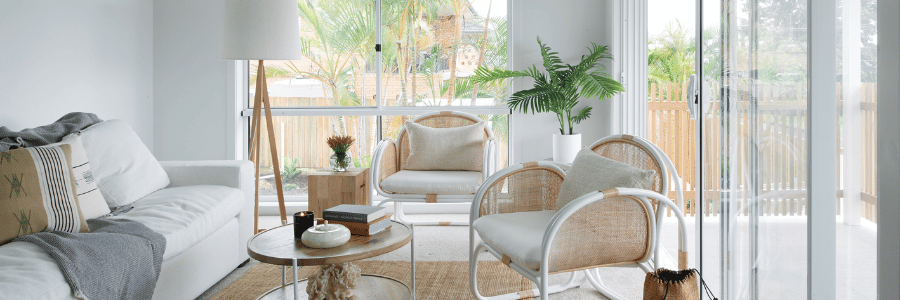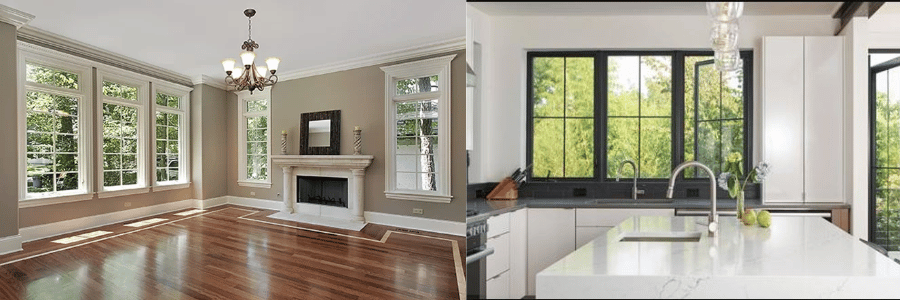When it comes to creating a comfortable and healthy living environment, the role of windows extends far beyond just aesthetics and natural light. Windows are essential components in regulating your home’s ventilation and airflow, both of which significantly influence indoor air quality, temperature control, and overall comfort. In this blog post, we’ll explore how windows impact your home’s ventilation and airflow and why they are crucial for ensuring a fresh, healthy living space.

The Importance of Proper Ventilation
Ventilation is the process of bringing in fresh outdoor air while expelling stale indoor air. Proper ventilation plays a critical role in maintaining air quality by reducing the buildup of pollutants such as dust, allergens, carbon dioxide, and moisture. It also helps control temperature, humidity, and odor levels, creating a more comfortable environment.
Without adequate ventilation, your home can become a breeding ground for dust mites, mold, and other allergens, leading to health problems such as respiratory issues, allergies, and asthma. This is where windows come in—they provide an essential means of improving airflow and ensuring that fresh air circulates throughout your home.

How Windows Facilitate Ventilation and Airflow
Windows are key players in controlling airflow in and out of your home. By opening windows strategically, you can create cross-ventilation, which allows air to flow freely from one side of your home to the other. Cross-ventilation is one of the most effective ways to cool down a room naturally, as it facilitates the exchange of hot indoor air for cooler outdoor air.
Here’s how different types of windows contribute to ventilation:
Casement windows, which open outward like a door, are known for providing excellent airflow. Their design allows you to catch the breeze from a wider angle, increasing the amount of air that can enter the room. When positioned on opposite walls, casement windows can create a strong cross-breeze, enhancing airflow throughout the space.
Sliding windows open horizontally and can be a great option for homes with limited vertical space. Although they don’t allow for as wide of an opening as casement windows, sliding windows still enable good airflow, especially when opened fully. They are a popular choice for areas like kitchens, living rooms, and bathrooms, where ventilation is essential for both comfort and air quality.
Double-hung windows, which feature two vertically sliding sashes, are another versatile option for promoting airflow. You can open both the top and bottom sashes to allow hot air to escape from the top while fresh air enters from the bottom. This dual-function design encourages better circulation and reduces the buildup of stagnant air.
Awning windows are hinged at the top and open outward, allowing air to flow even during rainy weather. They provide excellent ventilation while still protecting your home from the elements. Their design also allows for continuous airflow, even when it’s windy, making them ideal for spaces that need consistent ventilation.
The Role of Window Placement and Size
The placement and size of windows are critical factors in optimizing ventilation and airflow. Larger windows or multiple windows positioned on opposite walls encourage better airflow by allowing more air to enter and exit the room. Additionally, the orientation of the windows matters—windows on the windward side of your home will facilitate better natural ventilation than windows on the leeward side.
Strategic placement also promotes cross-ventilation. For example, opening a window in the kitchen while simultaneously opening a window on the opposite side of the home can encourage air to flow through, carrying away heat and odors. This type of natural cooling can help reduce your reliance on air conditioning and improve overall indoor air quality.

Natural Cooling and Energy Efficiency
Windows are an essential tool for natural cooling. When positioned correctly, they can reduce the need for air conditioning by allowing cool breezes to enter and warm air to escape. This is particularly beneficial during mild weather, as it reduces your home’s reliance on electricity-powered systems, lowering energy consumption and costs.
In addition, some modern windows are designed with advanced energy-efficient features, such as low-emissivity (Low-E) coatings and thermal breaks, which help regulate indoor temperatures while promoting ventilation. These features reduce heat transfer, keeping your home cooler in the summer and warmer in the winter, further contributing to energy efficiency and comfort.

Managing Humidity with Windows
Humidity is another key factor that impacts indoor air quality and comfort. Excess humidity can lead to mold, mildew, and condensation on windows, contributing to poor air quality. Windows play a crucial role in managing indoor humidity levels by allowing moisture-laden air to escape and facilitating the flow of drier outdoor air.
In areas with high humidity, such as bathrooms and kitchens, windows are essential for reducing moisture buildup. A well-placed window can help prevent mold and mildew growth by promoting airflow and moisture control. Opening a bathroom window during or after a shower helps prevent condensation from settling on walls and mirrors, maintaining a healthier environment.

Improving Indoor Air Quality
In addition to reducing humidity and promoting temperature control, windows are essential in improving overall indoor air quality. Pollutants from cooking, cleaning, and other household activities can accumulate over time, causing discomfort and respiratory issues. By opening your windows regularly, you can flush out these pollutants and let fresh air circulate throughout your home.
For homes located in areas with higher pollution levels or on busy streets, air filtration systems paired with strategically placed windows can help ensure that only clean, fresh air enters the home. Some window designs, like those with screens or ventilators, allow fresh air to come in while filtering out dust, debris, and insects.

Conclusion
Windows are much more than just decorative elements of your home. They are vital in maintaining proper ventilation, controlling airflow, and ensuring healthy indoor air quality. By understanding the different types of windows and how to use them to promote cross-ventilation, you can create a more comfortable, energy-efficient, and healthy living environment. Whether you’re building a new home, renovating an existing space, or simply looking to improve airflow, the right windows can make all the difference in enhancing the comfort and well-being of your home.

